Breakdown
Climber: Cassie Sciortino 4’11”/+6
Wall Angle: Roof > 10° Overhang
Holds: eGrips Jibber Jabber Super Jugs, Rock Candy Buckets, Teknik Bullies, Teknik Fat Pinches, Teknik Hefty Husky Pinches, Teknik Geeks, Urban Plastix Changing Corners Pinches
RIC: Risk 1, Intensity 5, Complexity 1
The concept of this boulder was to create a situation where the climber is encouraged to climb “feet first.” This generally requires the climber to invert, and place their feet above their hands. While this move can be challenging to incorporate at earlier grades, this was an attempt to make this specific move highly accessible. Risk and Complexity were avoided on this boulder by introducing movement in a high success, straightforward manner. Intensity is high on this boulder because of the endurance needed to climb the boulder in its entirety.
Influence/Aesthetic:
The goal when setting was to introduce the climber to a type of advanced movement. This caused the boulder to take a foundation in function rather than aesthetics. There are many clusters of holds scattered throughout the boulder, but these were placed to give climbers a multitude of options to navigate the sequence as opposed to adding complexity or aesthetics. When a climb is designed around teaching specific movement, it is imperative to provide numerous context clues to guide the climber to the intended sequence.
Hold Selection:
The steep angle of the roof was the biggest factor in determining hold choice. The target grade requires almost all of the holds to be positive jugs, but there are some exceptions made to create the desired movement. The hands gained before the “feet first” movement are slightly worse than the rest of the holds on the climb. This makes it more intuitive and less difficult to do the intended sequence, rather than to campus through it.
Getting Started
The opening moves of this boulder require repetitive movement of building feet and gaining higher underclings.
Once Cassie reaches the large gap between the underclings and the next set of downpulling holds, she brings her left hip into the wall to begin generating momentum.
Bring It Around
Using her momentum, Cassie is able to do a large span move to reach the next set of holds.
Spanning this distance causes her to be “stuck” because there are no foot options below her to help her release the tension between her arms.
Additionally, the next set of hands is slightly less incut, which makes her unable to campus through the sequence.
She cuts feet and brings them overhead to gain the next footholds; this opposition turns the left-hand hold into an undercling that provides a more positive grip.
These points of contact allow her to release tension from her right hand and bring it closer.
Return to Course
Cassie begins to walk her feet and hands farther out to maintain tension, as she still has no options for her feet behind her.
Once far enough, she is able to gain more positive hand holds, and the holds used previously are close enough to be used as feet.
She then rotates her body to place her left foot behind her. This gives her a point of opposition to gain the next underclings.
Repetition
Cassie fully turns to resume her same body orientation from the lower part of the boulder.
Her hands and feet are continually shuffled while flagging to maintain tension and balance through the roof.
Lip Encounter
Cassie uses her right hand undercling and left foot to bring her hips into the wall while moving her left hand over the lip.
Her right foot is moved above the lip to begin shifting her weight out from under the roof.
Gaining the next right hand allows her to center her body on the corner of the wall, allowing her to move her left hand and foot up again.
Taking the Top
Cassie continues to move her right hand farther; this positions her body farther around the right side of the corner.
Before moving to the finish, she brings her left foot up to center her body on the corner for stability when matching the finish.
Final Thoughts
Teaching climbers new movements can be one of the most perplexing parts of routesetting. While routesetters generally want moves to be “forced”, forced movement can often lead to uncomfortable positions for the climber. This discomfort can cause users to look for a multitude of solutions to avoid a routesetter’s intention. Easing climbers out of their comfort zone can be accomplished with intuitive movement. If the movement feels natural for the user, they are more likely to learn, repeat, and improve on it in the future.






